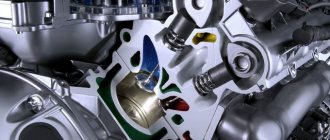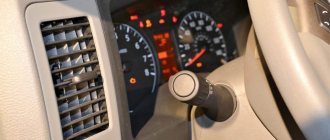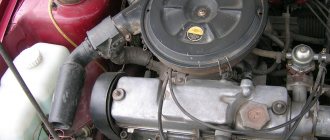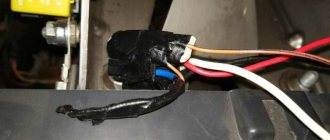The products of the domestic automobile industry are not of high quality, and at first glance it is not so easy to determine the common reasons why the VAZ 2106 stalls or does not start at all. Malfunctions can be in everything - in electrical equipment, in the ignition system or in the power system. Perhaps the spark has disappeared on the VAZ 2106 or it is related to the idle air regulator. Therefore, to help the car figure it out, let’s look at the main reasons why the car won’t start and stalls. To troubleshoot problems, we will study useful recommendations from specialists.
If the car won't start
If the VAZ 2106 does not start, you must first identify the true reason. The probable causes of such a problem and possible ways to solve it are as follows.
- The car may not start due to faulty breaker contacts. To confirm or eliminate the risk of such a malfunction, it is necessary to check the condition of the contacts mentioned for the presence of gap violations or oxidation (burning) of the working surfaces. In the first case, you will need to adjust the gap, in the second, you will need to clean or replace the working surfaces. The compression spring will also need to be replaced if necessary.
- The problem may lie in the low voltage wiring of the VAZ 2106 car or in loosening (oxidation) of the wire terminals. You should check the wires going from the ignition coil to the distributor for breakdown and short circuit. There may also be problems with the ignition switch, which needs to be checked, and if it is faulty, it must be replaced or its contact group must be changed.
- There is a possibility of failure of the ignition coil, that is, the spark in the VAZ is lost. Perhaps the problem is a short circuit in the primary winding of this coil, which can be corrected by swapping high-voltage wires. If a spark on a VAZ 2106 appears in a place where it was not there before, but disappears on a new one, this indicates a fault in the spark plug wire.
- Problems with ignition distribution. The distributor capacitor may be broken; therefore, for normal operation of the car, it must be replaced. It also happens that the distributor is installed incorrectly, this leads to the car jerking during acceleration and then stalling.
Main reasons
The reasons that the speed of the power unit does not decrease differ for cars with injection and carburetor engines.
On carburetor engines
In cars equipped with carburetors, it is this unit that is responsible for preparing and supplying the air-fuel mixture to the combustion chambers. Most often, problems with high speeds are associated with an over-enrichment of the fuel-air mixture, but other causes of malfunction may also occur.
The effect of increased speed can be caused by the following problems.
- Incorrect operation of the throttle valve responsible for the air supply. If the damper, after releasing gas or warming up the engine, cannot close tightly, and a gap forms in it, then an enriched fuel-air mixture enters the engine.
- Open suction. Choke is a control knob for adjusting the air damper, which is responsible for the flow of air into the carburetor. With its help, you can enrich the fuel-air mixture with air. If the suction is not working correctly, the mixture becomes over-enriched with air.
- Needle valve position. In this case, the incorrect dose of fuel will enter the combustion chamber. A malfunction of the needle valve can manifest itself in different ways, including the absence of a drop in speed.
- Incorrect idle speed adjustment. This problem is often encountered by car owners who have changed or repaired the carburetor.
- A fairly rare cause is a burnt-out cylinder head gasket. The problem is manifested not only by increased engine speeds, but also by the appearance of white smoke from the engine compartment.
On injection engines
For cars equipped with injection engines, the range of reasons for increased speed is wider. This is due to the fact that such cars have many more electronic devices and sensors that are responsible for transmitting information to the electronic control unit that regulates engine speed. Therefore, disturbances in engine operation can be associated with both mechanical damage and malfunction of electronic systems.
The reason for the increased speed of injection engines may be one of the following problems.
- Incorrect operation or failure of the coolant temperature control sensor. With such a malfunction, the engine constantly operates in warm-up mode, since the ECU (electronic control unit) does not receive information from the sensor that the engine is already warmed up. As mentioned above, in this mode the engine speed is increased.
- Failure of the mass fuel flow sensor (MAF), which is also called the idle speed sensor. A malfunction of the mass air flow sensor can manifest itself in different ways - a loss of speed or an increase in speed. In the latter case, the engine also goes into constant warm-up mode.
- Throttle position sensor malfunction. In this case, a sensor malfunction may be perceived by the ECU as information about an open throttle valve. Then the control unit gives a command to increase the speed.
Also, the reasons for the increased speed of injection engines can be associated with mechanical damage.
- Broken throttle return spring.
- Sticking throttle cable.
- Damage to the injector gaskets.
Why does the car stall while driving?
As for the most common malfunctions that many drivers of VAZ cars encounter, the list of common reasons includes those that lead to the fact that the domestic car 2106 stalls while driving. Let's look at them in detail.
- Low quality of fuel used. This is where experts recommend starting to look for the source of the problem. If, when draining the old fuel and replacing it with a new one, you are lucky and the car starts, you can confidently say that you should not skimp on the quality of gasoline for your car.
- Candles. Often, after changing the fuel and the problem persists, that is, the VAZ still does not start, suspicion falls on the spark plugs. You should check their condition after they are unscrewed and, if necessary, replace them with new ones.
- Fuel filter. Very often, a clogged filter can provoke interruptions in the fuel supply, as a result of which the VAZ 2106 stalls while driving. To eliminate the problem, it is enough to replace the fuel filter.
- Problems with the air filter are solved using the same method as with the fuel filter. A clogged filter does not allow air to pass through, which leads to engine pressure, that is, a drop in power. This way, the combustion process of the mixture will not take place, and as a result, the engine will stall.
- The problem is the fuel pump. A faulty fuel pump causes the VAZ 2106 to stall or not start at all. Treatment is checking the pump followed by repair or replacement.
- Battery: oxidation or poor terminal contact. The terminals should be checked, and then the battery should be cleaned or replaced.
- If the engine stalls while driving and won't start again, the cause may be the generator, which is not providing a charge. And since the car is powered only by the battery and, as you know, it doesn’t last long, the car starts working on the battery until it is completely empty.
- In modern brands, the cause of breakdown can be faulty electrical equipment. With such a problem, it is better to immediately contact specialists, because without experience and knowledge, you can replace half a car, but not get rid of the problem.
This concludes the review of the reasons leading to the VAZ 2106 not starting or stalling while driving. Spare no effort, time and financial resources for the well-being of your car, and it will respond with high-quality and long-term service.
As a rule, the true cause of the breakdown is revealed quite simply. And even a car owner who does not have deep knowledge of vehicle repair can easily correct problems that arise that are accompanied by incorrect behavior of his car.
The engine does not idle: the main reason
The first thing you need to pay attention to is the solenoid valve. It is installed, however, not on all VAZ 2106 carburetors
It is this small device that most often falls into disrepair. Its operating principle is similar to a solenoid relay - there are windings, an armature, and a return spring, but the dimensions are somewhat smaller.
The function of the solenoid valve is to open the path for gasoline to flow (with the throttle valve closed) when the ignition is turned on. And close when disconnected, respectively.
The most common breakdowns of the solenoid valve, as a result of which the idle speed disappears:
- The winding is destroyed, the armature with the needle does not move, fuel is not supplied.
- The fuel nozzle located on the edge of the valve is clogged.
- The valve armature is jammed due to deformation.
You can check this device very quickly; you will need a small piece of wire, stripped from both edges. Connect one end to the positive side of the battery, and connect the other end to the terminal of the solenoid valve. There should be a fairly loud click, but if it doesn’t, then most likely the winding is damaged.
If there is a click, remove the wire connected earlier and turn on the ignition. Place the power connector onto the valve. If there is no click, then the wiring is damaged. In the event of a breakdown, there can be three exits, you can use any:
- If the solenoid valve is completely destroyed, it would be wise to unscrew it and remove the tip (fuel nozzle). And thus get to the nearest store without much difficulty. The price of a new VAZ 2106 solenoid valve is about 100 rubles, so repairs will not be expensive.
- Temporarily connect the output of the solenoid valve to the positive terminal of the battery - if the wiring is damaged. But in this case you will have to remove the wire during each stop.
- It would be much more efficient to run a wire from the solenoid valve output to the “+B” ignition coil contact. The fact is that voltage appears on it only after the ignition is turned on.
The cause of a stalled engine is the spark plugs
In 50% of cases, the problem is due to the fact that the spark plugs simply do not produce a spark. This failure occurs as a result of 3 reasons:
- contacts become clogged;
- plaque forms along the entire contour of the candle;
- malfunction when supplying voltage to the spark plug.
However, the most popular is still black carbon deposits on the spark plugs, which prevents the spark from appearing or causes it to work periodically.
Tip: if the spark plug set malfunctions, you will hear a “triple” sound that is uncharacteristic of the engine. In this case, the car will jerk strongly while moving. As a result, the engine will either stall on its own, or you will need to turn it off and turn the ignition on again.
If you see dirt on the surface of the contacts, this indicates the need to replace a low-quality type of fuel or check the serviceability of the oil supply systems. It is the oil supply adjustment sensors that can splash the spark plugs with it if there is a problem. Also, oil that appears on a set of spark plugs may indicate serious damage to components in the engine cylinders. Be sure to check the engine at a car service center. Otherwise, further operation may lead to expensive replacement of jet rods and even the entire set of pistons.
If you systematically use low-quality gasoline samples, you may find a red-brown coating on the contour of the spark plug. In this case, cleaning will not help - it is better to immediately replace the entire set after a new refill. If you find that the car periodically turns off at full speed, but starts easily even with clean spark plugs, then the problem lies in the electrical wiring.
Ignition system failure
There are quite a few reasons for this: they may be interrelated. What causes system failure?
- Failure of the ignition coil. As a result, the high-voltage pulse stops flowing to the distributor: there is no spark, and the car cannot be started.
- Worn spark plugs. On poorly functioning parts you can see a thick layer of carbon deposits. Sometimes interruptions are due to incorrect gap between the electrodes.
- Malfunction of the ignition distributor (distributor - for carburetor engines).
Irregularities in electrical wiring
The first thing to do is to check the reliability of the connection of the contacts (“ground”) of the battery, generator, and the engine body. Also, the reason may lie in the lack of voltage supply to the ignition coil due to a blown fuse. Bad, wet or worn high-voltage wires also cause interruptions in the operation of the motor.
Poor contact of the battery terminals with the vehicle's on-board network can lead to damage to the controller (ECU).
The cause of a stalled engine is a power supply failure
In this type of problem, 3 reasons may be involved:
- Poor contact with the terminals of the new battery;
- Detection of poor contact or breakdown along the entire length of high-voltage wires;
- The appearance of malfunctions in the generator or ignition coil system of the car.
If the problem lies in damp high-voltage wires, then it is best to replace them completely along with the battery contacts. If the terminals make poor contact, you need to carefully clean them with sandpaper and try to reconnect them. If the generator is found to be inoperable, the problem usually boils down to problems in the following parts:
- Broken timing belt;
- There is a malfunction inside the housing of the unit itself.
A problem with the generator is easily detected when the corresponding indicator on the dashboard turns on. In addition, if there is insufficient energy supply, the backlight of the on-board panel will gradually fade, and a set of other diagnostic sensors will show incorrect values.
Advice: if when you press the gas the car jerks, then stalls and cannot start, then the problem is related to the failure of the ignition coils. It is best to replace these parts in a car service using special equipment.
From the list of reasons that are directly related to the car engine, you need to move on to problems that arise in the fuel and air supply systems, as well as malfunctions of components responsible for exhaust gas removal.
Setting the gasoline level in the float chamber
To adjust the float in the DAAZ carburetor, the entire assembly itself does not need to be removed, but partial disassembly is necessary. To carry out adjustment work, perform the following steps:
turn off the engine, open the hood; dismantle the air filter cover (unscrew three nuts);
remove the filter housing itself (four more nuts);
disconnect the choke cable; remove the telescopic rod of the starting device;
unscrew the five screws securing the carburetor cover (they need to be carefully removed and reassembled, it is important not to drop the fasteners into the manifold); for ease of operation, disconnect the fuel supply hose;
turn the lid over and determine the gap between the float and the cardboard spacer, it should be within 6-6.5 mm; if the gap differs from the required value, we make the adjustment by bending the tongue; It will also be necessary to align the float itself on a plane; it may be beveled relative to the surface of the lid.
When adjusted correctly, immediately after removing the cap, the gasoline in the float chamber is approximately at the level of the middle of the beveled surface of the carburetor body, and the float stroke is about 14 mm.
Fuel supply faults
It is quite easy to find out that the car stalls while driving due to the engine being “choked” with the fuel mixture - during a long drive you will find that the signal of the sensor responsible for this function is constantly on.
Here the problem lies in low-quality fuel, which does not quickly “ignite” from the spark of the candles. It can also be caused by gasoline not meeting the requirements for the octane number specified in the vehicle specifications. If there are problems with fuel, the gas pedal will be pressed all the way, and the car will not begin to gain speed. In addition, the car will periodically stall when the clutch is engaged.
Another symptom indicating problems with fuel is the appearance of problems with the car after refueling. The problem is characterized by a rapid drop in engine power at full speed, as well as when constantly changing gears. The way out of the situation is to completely drain the bad fuel mixture, wash the engine and all the fuel system pipes.
Also, the car will constantly stall if there is an interruption in the supply of the fuel mixture. This may be due to contamination in the following system components:
- Dirt in the fuel filter;
- Problems with injector nozzles;
- Dirty throttle valves;
- Fuel pump power failure.
The main symptom of a malfunction of these parts is that there will be a gradual drop in the power of the car’s engine, after which the car will stall even after sharply pressing the gas pedal. If you do not release the clutch carefully when changing gears, this will also cause the engine to stall.
Poor quality fuel
The fact that this is the reason for the sudden stop of the engine can be understood if the problem arose after you refueled. Moreover, the motor may not stop working immediately, but after some time. Usually, the “triple” or twitching begins first. Sometimes after stopping the engine it is possible to start again, but then history repeats itself. There is only one way out - wait until the refueling is normal, buy high-quality fuel to replace the filled one (you also need to install a new fuel filter).
Malfunctions in the air mixture supply system
Here the problem lies either in a clogged air filter or in the failure of the regulator responsible for idling the car. In this case, your car will stall all the time when you gain speed or when you release the gas when you release the accelerator.
To solve the problem, remove and inspect the air filter. If there is serious contamination or chips, replace it. To diagnose and replace the idle speed regulator, you will need the help of qualified car service employees.
Broken timing belt
This malfunction can be determined if you remove the special casing (in some cars it is enough to bend it a little). Replacing a belt takes a little time (20-30 minutes) for an experienced car owner. However, the situation is worse if, at the moment the engine stopped, a blow was heard from its side. This indicates a “meeting” of valves and piston heads, when the latter do not have special grooves that prevent collision. It’s worth finding out in advance whether you really have a car with such pistons: if so, pay special attention to the condition of the belt, otherwise you may face a major repair.
Car exhaust system problem
The engine may also stall if the tubes responsible for removing gases are malfunctioning. At full speed, the car will quickly begin to “choke”, and pressing the gas pedal completely stops the engine. Malfunctions in the operation of the exhaust pipe system in 90% of cases are caused by contamination and clogging of the muffler. However, the catalyst may also fail.
In the first case, carefully clean the muffler and remove foreign objects from there. If there are problems with the catalyst, conduct a complete diagnosis of the exhaust system and replace this element.
Troubleshooting carburetor problems
Regardless of whether an EMC is installed or not, the procedure for cleaning the idle fuel jet is the same.
- Unscrew the plug holder or EMC.
- Unscrew and remove the fuel jet XX.
- Clean the central channel of the jet.
In order to remove the XX jet from the radiator body, you will need a 13-size wrench, but depending on the design, a 14-size wrench can also be used. After turning the EMC, remove the nozzle. If the center hole is clogged, carefully clean it with a thin wire or blow it out with compressed air.
Once the fuel jet center channel is clean, reinstall it.
Screw in until it stops and tighten carefully with a wrench. Connect the “positive” wire to the power terminal of the EMC
Start the engine.
Do-it-yourself carburetor adjustment for VAZ 2107
To make it easier to work with the carburetor, it is necessary to remove the air filter. Turn on the ignition, first removing the power wire from the EMC terminal. Touch the power wire to the valve terminal. A distinct click indicates that power is coming to the EMC input. In this case, the cause of the malfunction should be sought in the jet or in the carburetor itself. The absence of a click indicates that the fault is in the solenoid valve or fuse. To check the valve, connect the “plus” of the car battery to the terminal of the EMC, and the “minus” to its body. If there is no click, the solenoid valve is faulty and must be replaced.
If power does not come to the EMC input, the reason may be a faulty wiring or the need to replace an 8A fuse. If you have a standard fuse box, then this part is installed in the 9th cell.
What to do if cars with automatic transmission stall?
If your vehicle has an automatic transmission, then the problem should be found in the electrical supply. If you abruptly switch from one gear to another, or while switching gears while braking, the settings may be distorted, and the on-board computer will receive a signal to turn off the engine.
Also, models with automatic transmission may stall due to malfunctions of the hydrodynamic transformers of the gearbox. This problem mainly manifests itself during acceleration and requires urgent intervention from car service specialists.
Checking the fuel pump
What to do if the scooter does not start when cold
The part in question has a relatively simple structure. Rotation is carried out using a special pusher driven by a long steel rod. You can check the pumpless pump without removing it from the engine:
- you should remove the fuel pipe from the filter installed after the pump or disconnect the line in another place accessible for clear viewing;
- Then, using a special pedal, you need to pump the fuel.
The back of the part is equipped with a special lever. If you start pumping it, then gasoline should start flowing through the fuel line. Its absence indicates a malfunction. In this case, the easiest way is to purchase a new fuel pump. Its cost is no more than 1 thousand rubles. It is also possible to carry out repairs - but the cost is comparable to buying a new part.
The car jerks while driving: we find and eliminate the cause
Almost every driver has encountered such an unpleasant situation when the car began to twitch during acceleration, at low speed, or even at the very beginning of movement. Experienced car enthusiasts say with confidence that such a problem can happen to any car, regardless of age and make. Jerks in motion can be observed both in the Chevrolet Niva and in any other car. If your car begins to jerk while driving, it is recommended to find the cause as quickly as possible and eliminate it in time.
Often, every driver can eliminate such an ailment without the help of specialists at a service station. Ignoring the problem can not only aggravate the situation, which will subsequently require expensive repairs, but also jerking the vehicle often leads to an accident. A faulty car is unable to start a smooth ride and then accelerate. A jerking vehicle not only instills fear and terror on other road users, but also knocks them out of the way. Next, let's try to figure out what can cause the uneven running of the car.
VAZ 2106 carburetor starts poorly when cold with suction
I have a problem. Before cleaning the carburetor, the DAAZ 2107-1107010 was idling at its top five, either at maximum or completely absent, the car had difficulty gaining momentum, in general, I often drove with my hand on the choke, BUT IT STARTED WITH A HALF-TURN. I washed it: it runs smoothly, without interruptions, without failures when hot, but it STARTS almost from the pusher. I disassembled everything except the damper drive. I cleaned it with a spray (in general, a lot of crap leaked out), I didn’t change the jets, I took out the float, barely breathing on it. IT'S SO DIFFICULT TO START IT'S HORRIBLE. It warms up a little and works like a clock. What could be the problem
The car is shaking, what should I do?
At the first stage, the machine is diagnosed. Let's say that you have a VAZ 2106 with a carburetor engine in your garage. Your car already shows signs of “illness” at the first stage of movement. Or the car started moving without any hassle, but when a certain number of revolutions was reached, the engine malfunctioned. All this will not give answers, but only creates questions, because anything can break. In any case, if unstable operation of the car’s power unit is noticed while pressing the accelerator pedal, the first thing you should do is:
Carburetor car engine starts and stalls
In this article we will take a closer look at the situation when a carburetor engine of a passenger car (VAZ 2108, 2109, 21099, 2105, 2107 and their modifications) starts and stalls due to a carburetor malfunction. Malfunctions of carburetors 2105, 2107 Ozone, 2108, 21081, 21083 Solex and their modifications will be considered.
Symptoms of a problem
Causes of the malfunction “carburetor engine starts and stalls”
— There is no fuel in the float chamber
Pump it up using the manual pump lever on the fuel pump.
The fuel pump or power system may be faulty. Remove the hose from the carburetor fuel supply fitting and press the manual primer lever on the fuel pump several times. A strong pulsating stream of gasoline should come out of the hose hole. If it is missing or weak, check the fuel pump or power system.
Checking the VAZ fuel pump
— The mesh filter at the inlet to the carburetor is clogged
Details of strainer filters for fuel purification of carburetors 2108, 21081, 21083 Solex, 2105, 2107 Ozone
— The solenoid valve is faulty or the fuel jet of the idle system is clogged
Solenoid valves of carburetors 2108, 21081, 21083 Solex, 2105, 2107 Ozone
Check the serviceability of the valve itself by unscrewing it from the carburetor and removing the fuel nozzle from it. The jet should be carefully inspected for contamination and deformation. We also check the ease of movement of the valve shut-off needle, the presence and integrity of the rubber O-ring on the valve body.
Carburetor solenoid valve design
Unscrew the idle air system fuel nozzle holder (on carburetors with a holder instead of a solenoid valve), rinse, clean the fuel nozzle and blow with compressed air.
— “Suction” of foreign air into the carburetor
In this case, the fuel mixture is lean. If the engine starts and immediately stalls, it is most likely very lean. The image shows probable places where foreign air is “sucked in” on the 2108 Solex carburetor.
Places of possible “suction” of foreign air into the carburetor 2108, 21081, 21083 Solex
Read more about the “suction” of foreign air in the article “Suction of foreign air into the carburetor.”
— The trigger diaphragm is damaged or it is not adjusted
Disassemble the starter housing and replace the diaphragm with a new one. Adjust the starting device.
Starting devices for carburetors 2108, 21081. 21083 Solex, 2105, 2107 Ozone
— Fuel and air jets, emulsion wells and tubes of the main dosing system are clogged
It is necessary to remove the carburetor cover, unscrew the jets, remove the tubes, rinse and clean them, clean the wells, blow everything out with compressed air and put it back. The image shows what should be cleaned on the carburetor 2105, 2107 Ozone.
Fuel and air jets, emulsion tubes and emulsion wells of GDS carburetors 2108, 21081, 21083 Solex, 2105, 2107 Ozone
— Fuel and air jets and channels of the idle system are clogged
Unscrew the jets, rinse and clean them, and blow them with compressed air.
Air and fuel jets for CXX carburetors 2108 Solex and 2105, 2107 Ozone
You can try to clean the idle system without disassembling the carburetor. Here is an article on this topic “Cleaning the idle system of the carburetor 2108, 21081, 21083 Solex.”
— The fuel level in the carburetor float chamber is broken
The fuel mixture is either very lean when the level is low or very rich when it is too high due to incorrect adjustment.
Approximate fuel level in the float chambers of carburetors 2108, 21081, 21083 Solex, 2105, 2107 Ozone
Articles on the site about adjusting the fuel level:
— The carburetor air damper drive is not adjusted (“choke”)
A not fully open choke causes the fuel mixture to become richer in some cases to such an extent that it is difficult to start the engine, especially when it is hot. The spark plugs may be flooded with fuel. Adjust the drive:
With the choke handle fully extended, the air damper should completely cover the cross-section of the first chamber of the carburetor.
The air dampers of carburetors 2108, 21081, 21083 Solex, 2105, 2107 Ozone are completely closed
With the handle fully recessed, the air damper should be strictly vertical.
The air dampers of carburetors 2108, 21081, 21083 Solex, 2105, 2107 Ozone are completely open
— The drain line from the carburetor to the gas tank (“return”) does not work
Drain line - “return” of the fuel system of the carburetor engine of VAZ 2108, 2109, 21099 cars
We eliminate jerks when the car starts moving
According to the number of reviews from owners of VAZ 2106 with a carburetor engine, it is the engine power system that most often poses a problem. Due to the breakdown of absolutely any element of the system, the stable process of fuel combustion in the cylinders can be disrupted. If an insufficient amount of mixture enters the cylinders, then the car in such conditions will not be able to produce the required power. Against the background of this problem, twitching will begin to appear.
Check the pipes, determine if there is any depressurization of the system. Measure the fuel pressure. If the indicator does not correspond to the norm, then further search for the cause should be sought in the pressure regulator, fuel pump. These actions must be performed not only with the carburetor system, but also with the injection system. If an injector is installed on a VAZ 2106, then in this version the ignition system is also connected. The cause of the car jerking can be absolutely any sensor that has failed. Perhaps in this case you will need the help of specialists, because all the work is complicated by the presence of an electronic unit.
Clogged filters
Engine stopping due to these seemingly minor elements is more typical for older cars. If the fuel filter is clogged, gasoline will simply stop flowing into the carburetor or ramp. Moreover, the car can stall “every once in a while.” A number of car models (this is especially typical for diesel engines) have several filters - coarse and fine. The cause of their contamination may also be the fuel tank, in which a lot of dirt has accumulated. In this case, it needs to be removed, washed, and dried.
Eliminate jerking when accelerating a car
If the VAZ 2106 begins to twitch when accelerating, then in this case it is necessary to carefully check the engine power system. The driver presses the speed pedal while driving, but the vehicle does not accelerate. By pressing the accelerator pedal, the driver provokes an increase in the amount of fuel mixture supplied to the cylinders. If this does not happen, breakdowns occur in a uniform manner.
We check all filters: fuel, air. A carburetor engine has 2-3 filters. We will not take into account the mesh in the neck, since it can only prevent the penetration of large particles. You should carefully check the filter that goes to the fuel pump. Often it becomes clogged with impurities, which ultimately prevents the free flow of fuel, causing the engine to starve.
Impact of sensors
VAZ 2114 starts poorly when cold
Most VAZ-2115 cars operate on the “January 5.1” controller. Crankshaft, temperature and throttle sensors are involved in starting the engine.
DPKV malfunctions usually appear regardless of temperature, but it is worth checking its resistance and comparing it with the data in the calibration table.
A more common malfunction is DT. Remove from position and place in a container with a cooler. We measure the resistance with a multimeter: it should be in the region of 1350 - 1880 Ohms. If you have a thermometer, you can check it using the table. If not, it doesn’t matter either, just heat it to an arbitrary temperature. As T increases, the resistance decreases. On a fully warmed up engine it is 87 - 109 Ohms. If the ohms do not change or drop to 0, change the DT.
The throttle assembly is completely disassembled and cleaned. One of the problems is dirt, which expands when heated and interferes with the normal operation of the injection. If the TPS malfunctions, the car not only does not start when hot, but also “does not drive” (sometimes stalls and does not start) after warming up.
The TPS is checked with an ohmmeter with the engine running. Place the multimeter on the input and output contacts, ask an assistant to press the gas. The readings should change and return to their original values at XX. If the resistance does not change when you press the pedal or the device shows infinity, the sensor needs to be replaced. At the same time we check the IAC. It usually causes the car to be unstable at idle or stall but start.
A malfunction of the mass air flow sensor on cars with January 5.1 is recognized by the fact that the car starts when hot and immediately stalls. The sensor comes into operation only after startup. But on a car with January 7.2, the mass air flow sensor is involved in the start - without it the car will not start.
Eliminate jerking when the car is moving steadily
If a Chevrolet VAZ 2106 exhibits twitching during stable movement, this most often happens due to problems with the ignition system. You can often hear car owners complaining that they just installed new spark plugs, but the engine has already failed. Detonation can occur even with new spark plugs due to incompatibility with the engine. If the spark plug fails, then the fuel will not burn completely, and breakdowns will begin in the operation of the power unit.
Checking the spark plugs is quite easy. The first thing you need to do is:
- Check the level of gaps on the unscrewed spark plugs. Check for any irregularities in the sparking process.
- A working spark plug produces a dark blue spark.
- If there is black carbon on the spark plug, then the problem may lie in a faulty ignition or faulty mixture formation.
If checking the spark plugs does not bring any results, you should check all wiring for oxidation and breakdowns. Don't forget about the coil and toggle switch. All elements of the ignition system, as in the case of a problem in the power system, are thoroughly inspected and checked for correct operation.
Pre-launch inspection and preparatory activities
If a VAZ 2107 car starts poorly when hot or does not function at all in normal mode, this means a loss of settings or an accumulation of minor faults. Engine technical inspection includes the following steps:
- Checking the levels of operating fluids in the engine crankcase, gearbox, cooling system and brake system.
- Carefully inspect the external surfaces of the engine for oil, antifreeze or fuel leaks. Particular attention is paid to the high-voltage wires that are connected to the spark plugs; the contacts must be clean without signs of burning or damage.
- During long-term parking of several days, gasoline evaporates from the float chamber, and the level is replenished using a hand pump.
The next action of the driver of the VAZ 2107 is an attempt to start the engine. To do this, you need to take a seat behind the wheel and set the gear shift lever to neutral. When turning on the starter, it is recommended to depress the clutch pedal to reduce the load on the battery. If the engine does not start after 5–10 rotations with the starter, you should stop trying and carefully inspect the carburetor and other components.
Carburetor does not supply fuel
Often the problem lies in the carburetor - and the car can start when cold and then stall. It will be difficult to check this part yourself, especially if you have no experience. The problem can be solved with special compounds designed for cleaning carburetors. To use them, just remove it and then spray the spray inside. Cleaning a carburetor is not an easy task even for a very experienced auto mechanic. You will need a special rinsing bath, as well as a compressor.
Sometimes it happens that the fuel pump is fully operational and the fuel reaches the carburetor normally. In this case, you can try the following:
- remove the air filter cover;
- the partner is looking inside the intake manifold at this time;
- turn the starter, press the gas pedal.
As a result of performing the above actions, fuel must enter the manifold. If it is missing for some reason, then the carburetor needs to be washed, it is not working properly
It is important to remember that there are many other reasons why the cylinders may not be getting into the cylinders. Each case must be considered individually
The procedure for returning the car to “life”
Let's say you find yourself in circumstances where the injection engine starts poorly or refuses to do so at all. There is no need to hesitate in such a situation - it is advisable to immediately begin resuscitation procedures. If you don’t have time to figure out the exact reason why the car doesn’t start well, then you should quickly carry out the following algorithm of actions:
- First of all, we check the availability of gasoline and battery charge. Is there something missing? Fill it up and light it up. Let's try to start. If there is no result, proceed to the next step;
- Next, we quickly analyze under what circumstances the car malfunctions. If it takes a long time or is difficult to start when hot, we first check the spark plugs for overheating (light carbon deposits) and the functioning of the fuel system. Otherwise, when the car malfunctions both cold and hot, a more comprehensive approach is required. As a rule, the following procedures are sufficient: checking spark plugs, wiring the ignition system, assessing the operation of the injector and fuel system;
- Note that most motorists manage to solve the problem, so to speak, with little loss, that is, by implementing the actions described above. If you are not one of the lucky ones and your car still takes a long time, starts poorly or refuses to work at all, you will have to act globally. Here it is better to take the car to a service station or a convenient garage and check the compression, timing adjustment, clean the injector, assess the condition of the fuel system and ignition devices. If there are any malfunctions, they must, of course, be eliminated.
How to start easier in cold winter
Advice! To make starting the engine in the cold season much easier, we recommend installing an auto-start alarm on your car.
Warming up every certain time. Fuel consumption will suffer, but the likelihood of starting in severe frost will increase
If the temperature drops below 20 degrees minus, you can set the engine to automatically start every three hours. This will not only allow you to get into a warm car in winter, but will also prevent the oil from thickening too much during severe night frosts, which will certainly have a beneficial effect on the condition of the engine as a whole.
No ignition when turning the key
The second broad area of searching for the problem is the electrical system of the car, due to a malfunction in one of the components of which the VAZ-2114 does not start and does not respond at all to turning the key in the ignition switch. To begin with, just in case, it’s worth checking the functionality of the battery under the hood: many drivers, when starting a deep search for a breakdown, forget about such a banal reason for the lack of current.
You must carefully and calmly make sure that the ignition switch itself turns smoothly, without encountering obstacles or jamming, which in theory could lead to an unsuccessful engine start
VAZ 2114 battery
Next, you should turn your attention to more specific components and assemblies, checking their serviceability one by one:
- Check the instructions for two relays - the starter and the ignition switch, which are located above the clutch pedal. You can evaluate their performance using the car manual, but usually they are simply replaced with ones that are known to be good for diagnostic purposes.
- A faulty starter, or more precisely, a solenoid relay: if it breaks down on the road, you can try tapping it lightly if it just jams. Having reached the overpass, you need to turn it manually - connect the body to zero on the battery, and the other contact to positive.
- If the starter actively begins to turn, the problem is not with it; if there is a current supply, but it does not turn, the brushes are broken. Lack of response will indicate a malfunction of the retractor relay, and a sharp and unpleasant sound will indicate a breakdown of the overrunning clutch in the starter.
Starter VAZ 2114
Nothing happens when I turn the key
On a VAZ 2114, this usually indicates a violation in the ignition switch - starter line, but one of the reasons for the breakdown “for blondes” is a dead battery, do not forget about it (checked with a voltmeter: it should be at least 11.8 V - and with a hydrometer, if the battery is serviceable : at least 1.22 in each jar).
Let's move on. The cause of such a malfunction may be a breakdown of the ignition switch cylinder, and the injector has nothing to do with it. If, when turning the key, new sensations arise (something catches, turning has become easier or, conversely, more difficult), that’s the problem.
Under the panel, approximately above the clutch, there are two relays: ignition switch and starter release. The reason may be a malfunction of one of them. They are checked according to the manual by a good electrician or replaced with a known working one.
Starter. Often the cause may be a jammed “retractor”. If you are standing in a field, you should try hitting it with something heavy like a large key (without fanaticism) - it may help. If the car is parked in a garage, you should remove the starter and try to start it directly from the battery.
To do this, press the housing to the zero terminal of the battery, install the wire with the alligator clip on the positive terminal of the battery and bring it to the positive of the retractor. If the starter tries to jump out of your hands, everything is fine (be careful, it is not recommended to carry out this procedure without basic knowledge of safety precautions and an assistant!).
If there is no reaction, the problem is in the retractor. If the relay buzzes, but the starter does not turn, the problem is in the brushes. If the starter makes a terrible sound, but does not turn, the problem is in the bendix.
If the starter turns, replace the battery and check the power supply to the chips that are connected to the starter (with an assistant, one turns the key, the other measures it with a multimeter).
The starter rotates, but there are no flashes
The next typical malfunction is the rotation of the starter in the complete absence of flashes. Here are the reasons why this could happen:
- broken timing belt. The first thing the owner of a VAZ 2106 should do when noticing the rotation of the starter without flashes is to check the integrity of the timing belt. It's simple: the starter rotates properly, but the torque is not transmitted to the crankshaft, since there is simply nothing to transmit it to, since the timing belt has broken (or has flown off the guides - this also happens if the belt is heavily worn and begins to sag). The solution is obvious: the timing belt will have to be changed;











